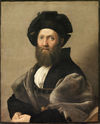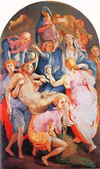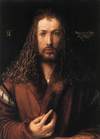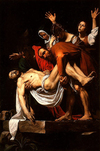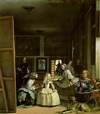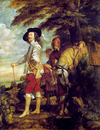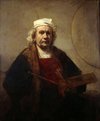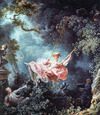Midterm Flashcards
(99 cards)

- Cimabue, Madonna Enthroned with Angels and Prophets, Late Medieval/Proto-Renaissance, Tempera & gold leaf on wood
- Texture and movement in clothing - light and shadow
- Moves away from flat represntation - illusion of 3 dimensions
- Somewhat proportional - Mary in relation to throne, Christ
- Traditional cue - Mary largest because she is most important figure
- Gold background - ends illusion of dimension - like Medieval paintings

- Giotto di Bondone, Madonna Enthroned, Late Medieval/Proto-Renaissance, Tempera & gold leaf on wood
- depth around throne - three dimensions
- attempt to replicate natural light (color of angels’ faces)
- symmetry of angels
- hierarchy of scale
- more realistic represntation of Mary and Christ as humans

- Giotto di Bondone, Lamentation, Arena Chapel, Late Medieval/Proto-Renaissance, Fresco
- focal point = Christ and Mary; not centered
- all people look toward them - range of emotion
- diagonal line/depth leading toward them
- emotional connection between Christ and Mary
- identity of front figures obscured - departure from medieval
- increase of private piety - individual practice
- playing with perspective

- Jan van Eyck, Man in a Red Turban, Late Medieval/Proto-Renaissance, Oil on wood
- new idea of portraiture - examination of personal power, presence, etc
- may be a self-portrait (based on frame inscriptions)
- attention to surface detail and minutia - area around the eyes - wrinkles, skin texture

- Jan van Eyck, Giovanni Arnolfini and His Wife, Late Medieval/Proto-Renaissance, Oil on wood
- less concern for anatomical accuracy
- abundance of textile = wealth
- convincing sense of perspective
- use of symbolism (dog, shoes, oranges)
- figures in mirror - one is probably van Eyck
Woodcut
prints using a subtractive process (removing parts of the material)
Fresco
mural-painting technique involving application of permanent lime proof pigments, diluted in water, on freshly laid lime plaster
Giornata
how much of a fresco can be painted in one day
Triptych
three-part panel painting (altarpiece)
polyptych
hinged multipaneled paintings
grisaille
monochrome/grayscale painting meant to mimic sculpture

- Gentile da Fabriano, Adoration of the Magi, Quattrocento Italy, Tempera on wood
- International Style
- altarpiece
- commissioned by Strozzi family
- suggestion of perspective
- contemporary style of dress
- flatness of figures
- concentration of gold and light on Mary & Christ
International Style
- Quattrocento Italy
- fusion of French Gothic, Sienese (Italy), and northern European (Belgium, Netherlands, Germany) manners
- Flourished in 14th-15th centuries
- appealed to aristocracy because of richness of appearance: brilliant color, lavish costumes, intricate ornamentation, elaborate themes
Factors contributing to development of Italian Renaissance
- Quattrocento Italy
- abundance of artistic talent (especially in Florence)
- economic prosperity
- wealthy patronage
- spread of humanism
Humanism
- emphasis on education and expanding knowledge
- individual potential and achievement
- civic responsibility
- impact on arts
- subjects selected from classical history and mythology (in addition to Christian subjects)
- participation in civic and religious commissions
- revival of portraiture
- interest in accurately depicting anatomy
- interest in developing perspectival systems (Brunelleschi - linear perspective)
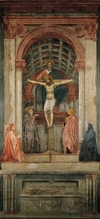
- Masaccio, Holy Trinity, Santa Maria Novella, Quattrocento Italy, Fresco
- convincing perspective - single vanishing point

- Masaccio, Tribute Money, Quattrocento Italy, Fresco
- circular direction of viewing - organize the space
- horizon line at eye level
- Atmospheric perspective (aerial perspective)
- halos have perspective
- biblical subject in new mode of representation
Atmospheric Perspective
- replication of effects of atmosphere on appearance of object as viewed from a distance.
- As distance between object and viewer increases:
- contrast between object and background decreases
- contrast of markings or details within the object decreases
- colors of object become less saturated and shift toward background color

- Andrea Mantegna, Foreshortened Christ, Quattrocento Italy, Tempera on canvas
- Foreshortening
- Christ’s body recedes backwards into space
- intentional manipulation of perspective - head too large, feet too small
Foreshortening
technique used in perspectival systems to create the illusion of an object receding strongly into the background, achieved by proportionately contracting in the direction of depth so that an illusion of projection or extension in space is obtained
Di sotto in sú
from below upward

- Lorenzo Ghiberti, Sacrifice of Isaac, Quattrocento Italy, Gilded bronze
- Quatrefoil - “four leaves”; decorative framework popular in Gothic design
- graceful figures
- linear perspective?
- Greek influences
- psychological drama/intensity

- Donatello, Saint Mark, Quattrocento Italy, Marble
- sponsored by linen guild
- contrapposto
- natural posture
- cloth moves around/accentuates body
- negative space around body - looks 3D
Contrapposto
Principle of weight shift







